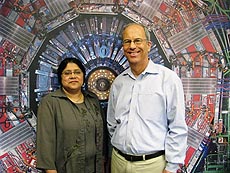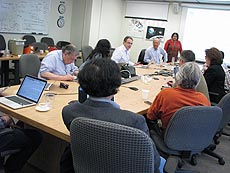New LPC leadership works to better the field of physics
 |
LHC Physics Center co-coordinators Meenakshi Narain (left) and Boaz Klima work to develop a vibrant community centered on LHC research. |
Every few years, two new individuals take over leadership of the LHC Physics Center to continue successfully supporting hundreds of remote CMS collaborators.
Meenakshi Narain, a professor of physics at Brown University, and Boaz Klima, Fermilab physicist, recently began as co-coordinators of the LHC Physics Center (LPC). They succeeded Ian Shipsey and Rick Cavanaugh.
Narain and Klima have known each other for years. Klima recruited Narain to DZero in the early 1990s as part of the group that discovered the top quark. They both have extensive leadership experience and complement each other in the qualities they bring to their roles. Narain highlights Klima's abilities to connect with people and put together a collaborative team, while Klima praises Narain's energy and ability to get things done.
As new leaders, they focus on continuing to improve the Fermilab-based center, which was already a successful place for collaboration, training and community.
"Thanks to our predecessors, the LPC is recognized worldwide as a center of excellence," Klima said. "It has been vibrant and stimulating and has helped to make its members more productive in many areas of CMS."
In their short time as LPC co-coordinators, Narain and Klima have undertaken several initiatives to increase opportunities for training, engagement and interaction between various CMS collaborators and with other members of the particle physics community. They have also worked to broaden the focus of the LPC's events and activities, which needed to accommodate the varied work happening during the LHC shutdown, including the detector upgrade and the preparations for Run II of the LHC.
They have increased the trainings, tutorials and special workshops as a way to help young scientists with their research, but they have also cast a wider net, involving theorists and others with a different set of skills. They work to ensure that they can accommodate the interests of all involved.
The result has been an increase in attendance at these events and a place where young people feel that they go to learn and grow. In short, they developed a community of scientists that works cohesively and efficiently toward common goals.
"It is rewarding to see how LPC members can effectively contribute and engage in CMS and the expertise we bring to the experiment," Narain said. "Members of our LPC community contribute disproportionately to a large number of papers, which shows me that we really have a powerhouse here."
—Rhianna Wisniewski
 |
The attendees at last week's meeting of the LPC Management Board at Fermilab included Abid Patwa, DOE program manager for the Energy Frontier; Tiziano Camporesi, CMS spokesperson; and Luca Malgeri, CMS physics coordinator.
|
|